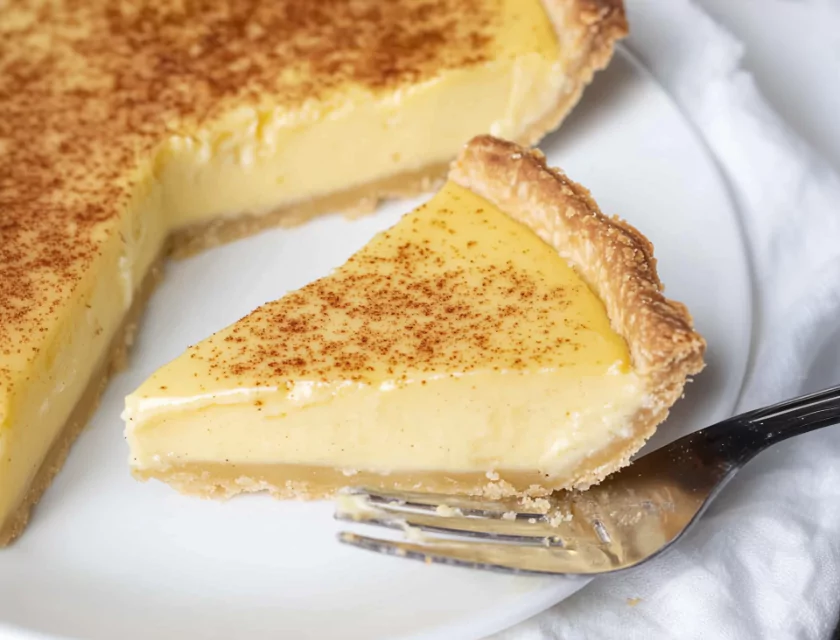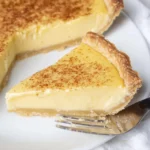The Old-Fashioned Vanilla Egg Custard Pie is a dessert steeped in tradition and nostalgia. Its silky, creamy custard filling and flaky, buttery crust make it a timeless favorite. This pie is a staple at family gatherings, potlucks, and holiday celebrations, offering a perfect balance of simplicity and indulgence.

Custard pies have a unique way of connecting generations. They evoke memories of grandmothers in the kitchen, holidays filled with warmth, and the comforting aroma of vanilla and nutmeg wafting through the air. In this guide, we’ll walk you through the steps to make the perfect vanilla egg custard pie, ensuring it becomes a cherished recipe in your own home.
The History and Cultural Significance of Custard Pie
Custard pies have a long history that spans centuries, originating in Europe before making their way to the United States. Early custard desserts were enjoyed by royalty and aristocrats due to their luxurious ingredients like eggs, cream, and vanilla. Over time, they became a popular dessert in American households, especially in the South, where recipes were passed down through generations.
The addition of vanilla as a primary flavoring is a relatively modern twist, showcasing the global influence on American culinary traditions. Today, custard pie is celebrated as a versatile dessert, perfect for everything from casual weeknight dinners to special occasions.
The Preparation Phase
Ingredients Overview
The quality of ingredients directly impacts the outcome of your custard pie. Let’s take a closer look at what makes each component essential:
- Pie Dough: A well-made crust is the foundation of any pie. Using Foolproof Flaky Pie Dough or high-quality store-bought dough ensures the perfect texture and structure.
- Eggs: The heart of custard. They provide the structure while giving the pie its silky texture.
- Sugar: Sweetens the custard while balancing the natural flavors of the milk and cream.
- Salt: Enhances the flavor profile without overpowering the sweetness.
- Vanilla Extract: The hero ingredient, adding warmth and depth to the pie.
- Heavy Cream and Milk: The combination creates a rich yet balanced custard filling.
- Nutmeg: A classic aromatic spice that elevates the flavor and provides a hint of nostalgia.
Essential Tools and Equipment
To achieve a flawless custard pie, you’ll need the following tools:
- Rolling Pin: For rolling out the pie dough evenly.
- Pie Plate: A 9-inch pie plate is ideal for this recipe.
- Pastry Brush: Useful for brushing egg whites onto the crust to prevent sogginess.
- Mixing Bowls: For whisking the custard ingredients.
- Whisk: To blend the custard mixture without incorporating too much air.
- Foil-Lined Baking Sheet: Protects your oven from spills during baking.
Preparation Tips for Success
- Chill the Dough: Keeping the pie dough cold ensures a flaky crust. Place it in the freezer for at least 15 minutes before baking.
- Blind Bake the Crust: Pre-baking the crust prevents it from becoming soggy once the custard is added.
- Don’t Overwhisk the Custard: Too much air in the custard mixture can create bubbles and affect the texture. Whisk just until the ingredients are combined.
- Strain the Custard: For a silky-smooth texture, strain the mixture before pouring it into the pie crust.
- Cool the Pie Crust: Ensure the crust is completely cool before adding the custard to avoid curdling the filling.
Step-by-Step Instructions
Preparing the Pie Crust
- Preheat the oven to 425°F.
- Lightly dust a rolling pin and surface with flour. Roll out the pie dough until it’s approximately 3 inches larger than your pie plate.
- Transfer the dough to the pie plate by gently rolling it onto the rolling pin, then unrolling it over the plate.
- Press the dough into the plate, trim the edges, and tuck any excess under. Crimp the edges using your fingers or a fork.
- Place the crust in the freezer for at least 15 minutes.
Blind Baking the Crust
- Remove the crust from the freezer. Crack an egg and separate the whites from the yolks.
- Use a pastry brush to coat the entire crust with egg white. This forms a barrier that prevents the custard from soaking into the crust.
- Bake the crust for 10 minutes or until lightly golden. If the edges slump, press them back into place with a spoon while the crust is still warm.
- Remove the crust from the oven and set it aside to cool completely.
Making the Custard Filling
- Lower the oven temperature to 325°F.
- Crack the remaining eggs into a medium-sized mixing bowl. Add sugar, salt, vanilla extract, heavy cream, milk, and freshly grated nutmeg.
- Whisk the ingredients until fully combined, ensuring there are no streaks of egg white or yolk. Avoid overwhisking to prevent incorporating excess air.
Assembling the Pie
- Place the cooled pie crust on a foil-lined baking sheet to catch any spills.
- Carefully pour the custard mixture into the crust, filling it just below the edge.
- Transfer the baking sheet to the oven. Pour the custard as close to the oven as possible to minimize the chance of spills.
Baking the Custard Pie
- Bake the pie for approximately 1 hour or until the edges are set, but the center remains slightly jiggly.
- Remove the pie from the oven and let it cool to room temperature. Then transfer it to the refrigerator to chill for at least 6-8 hours or overnight.
Serving the Pie
Top the custard pie with fresh whipped cream and a sprinkle of grated nutmeg for garnish. Serve chilled to enjoy its creamy texture and rich flavor.
Side Dish and Beverage Pairings
The Old-Fashioned Vanilla Egg Custard Pie is a versatile dessert that pairs beautifully with various sides and beverages. While the pie is delightful on its own, adding complementary flavors can elevate the experience even further.
Side Dish Suggestions
- Fresh Fruit Salad
A medley of seasonal fruits like berries, melons, and citrus adds a refreshing contrast to the creamy richness of the custard pie. The natural sweetness of the fruit balances the pie’s custard flavor while adding a pop of color to the table. - Vanilla Ice Cream
For an indulgent pairing, serve a scoop of vanilla ice cream alongside the pie. The creamy textures work harmoniously, while the cold ice cream offers a pleasant temperature contrast. - Light Sorbet
A tangy lemon or raspberry sorbet provides a palate-cleansing bite that enhances the pie’s sweetness. Sorbet is an excellent option for those who prefer a lighter pairing. - Candied Nuts
Toasted pecans or almonds with a sweet glaze add crunch and nutty undertones to the dessert. Sprinkle them over whipped cream for an extra layer of flavor and texture. - Homemade Whipped Cream
While this is a classic topping for the pie itself, serving additional whipped cream on the side ensures everyone can add as much as they like. - Caramel Sauce Drizzle
A light drizzle of caramel sauce over the custard pie or on the plate creates an extra layer of sweetness and sophistication. - Spiced Apples
Warm spiced apple slices cooked with cinnamon and nutmeg make an excellent pairing for fall gatherings. The warm spices complement the custard’s mild nutmeg flavor. - Cheese Plate
A selection of mild cheeses, such as brie or mascarpone, balances the pie’s sweetness while offering a savory element for those with less of a sweet tooth.
Beverage Pairings
- Freshly Brewed Coffee
A strong cup of coffee enhances the vanilla and nutmeg notes of the pie. Opt for a medium or dark roast to contrast with the pie’s sweetness. - Herbal Teas
Light herbal teas like chamomile or mint provide a soothing accompaniment without overpowering the dessert’s flavors. - Black Tea with Milk
The richness of black tea pairs wonderfully with custard pie, especially when served with a splash of milk to echo the creamy filling. - Dessert Wines
Sweet wines such as a late-harvest Riesling or Moscato add a luxurious touch to the meal. Their fruity and floral notes complement the vanilla and nutmeg in the pie. - Sparkling Water with Citrus
For a non-alcoholic option, serve sparkling water infused with lemon or lime slices. The effervescence helps cleanse the palate between bites.
Nutritional Information and Health Benefits
While the Old-Fashioned Vanilla Egg Custard Pie is a dessert meant for indulgence, its ingredients do offer some nutritional benefits. Understanding the nutritional profile allows you to enjoy this classic treat in moderation.
- Eggs: A great source of high-quality protein and essential vitamins like B12 and D. Eggs also contain choline, which supports brain health.
- Milk and Heavy Cream: These dairy products are rich in calcium, necessary for strong bones and teeth. They also contain vitamin A, which is vital for healthy skin and vision.
- Nutmeg: This spice contains antioxidants and has anti-inflammatory properties. A small sprinkle adds a lot of flavor while contributing to overall wellness.
- Vanilla Extract: Pure vanilla extract has trace amounts of antioxidants and compounds linked to relaxation. While its nutritional impact is minimal, it plays a significant role in the pie’s flavor profile.
However, the pie is also high in calories, saturated fats, and sugars, so it’s best enjoyed as an occasional treat. Consider serving smaller portions alongside lighter pairings like fruit salad or herbal tea to create a balanced dessert experience.
Common Mistakes to Avoid When Making Custard Pie
- Soggy Pie Crust
A soggy crust is one of the most common challenges in custard pies. To avoid this, always blind bake your crust and brush it with egg white before adding the custard. This creates a barrier that prevents the filling from soaking into the crust. - Overwhisking the Custard
Incorporating too much air into the custard can result in bubbles forming on the surface or an uneven texture. Whisk the ingredients just until combined, and avoid vigorous mixing. - Curdled Custard
Curdling occurs when the eggs in the custard cook too quickly. To prevent this, bake the pie at a lower temperature (325°F) and avoid overbaking. The center should remain slightly jiggly when the pie is done. - Spills During Transfer
Because custard is a liquid mixture, spills can happen while transferring the pie to the oven. Minimize the distance by placing the pie plate on a foil-lined baking sheet and filling it as close to the oven as possible. - Uneven Baking
Uneven baking can cause the edges of the pie to overcook while the center remains underdone. To prevent this, rotate the pie halfway through baking. If the edges begin to brown too quickly, cover them with aluminum foil. - Lumpy Texture
Lumps can form if the custard isn’t strained before baking. Always strain the custard mixture through a fine-mesh sieve to ensure a smooth filling. - Overbaking
Overbaking results in a rubbery texture rather than the desired creamy consistency. Keep an eye on the pie and remove it from the oven as soon as the edges are set and the center has a slight jiggle. - Serving Before Chilling
Custard pies need ample time to chill and set in the refrigerator. Serving the pie too soon can result in a runny filling. For best results, chill the pie for at least 6-8 hours or overnight.
Expert Tips for Perfecting the Vanilla Egg Custard Pie
Crafting the perfect Old-Fashioned Vanilla Egg Custard Pie requires attention to detail and a few insider tricks to ensure the best results every time. These expert tips will help you elevate your pie-making skills:
- Keep the Pie Dough Cold
A flaky crust depends on cold butter or shortening in the dough. If the dough warms up while rolling it out, return it to the freezer for a few minutes. This prevents the butter from melting prematurely and ensures a crisp crust. - Use Fresh Ingredients
The quality of your pie depends heavily on your ingredients. Use fresh eggs, high-quality vanilla extract, and freshly grated nutmeg for the best flavor. - Avoid Overfilling the Pie Crust
Pour the custard filling just below the edge of the crust. Overfilling can cause spills, which may lead to a messy oven or uneven baking. - Bake with Precision
Custard pies require low and slow baking to prevent curdling. Check your oven temperature with a thermometer to ensure accuracy, as overheating can ruin the pie’s texture. - Cool Gradually
Once the pie is baked, let it cool to room temperature before refrigerating it. Sudden temperature changes can cause cracks in the custard. - Avoid Over-Browning the Crust
Cover the edges of the crust with foil if they start browning too quickly during baking. This allows the custard to finish cooking without burning the crust. - Don’t Skip the Strain
Straining the custard through a fine-mesh sieve ensures a silky-smooth texture by removing any egg solids that may have formed during mixing. - Add Nutmeg at the Right Time
Freshly grate nutmeg directly over the pie before baking for a burst of warm, aromatic flavor. You can also sprinkle a bit on top before serving for an extra decorative touch.
Storing and Reheating Custard Pie
Proper storage is essential for maintaining the flavor and texture of your custard pie. Whether you’re making it ahead of time or saving leftovers, follow these steps to keep it fresh and delicious:
- Refrigeration
Always refrigerate custard pie after it has cooled to room temperature. Wrap it tightly with plastic wrap or aluminum foil to prevent it from absorbing odors from other foods. Custard pie can be stored in the fridge for up to 4 days. - Freezing
While custard pies are best enjoyed fresh, you can freeze them for up to a month if necessary. Wrap the pie securely in plastic wrap, then place it in a freezer-safe bag or airtight container. When ready to serve, thaw the pie overnight in the refrigerator. Note that freezing may slightly alter the custard’s texture. - Reheating
Custard pie is typically served chilled, but if you prefer it warm, heat individual slices in the microwave for 10-15 seconds. Be cautious not to overheat, as this can affect the custard’s consistency.
FAQs: Common Questions About Vanilla Egg Custard Pie
- Why is my custard pie watery?
A watery pie is often the result of underbaking or overbaking. Bake the pie until the edges are set, but the center still has a slight jiggle. Avoid refrigerating the pie too soon, as it needs to cool gradually to set properly. - Can I use store-bought pie crust?
Yes, high-quality store-bought pie crust can be a convenient alternative to homemade dough. However, a homemade crust offers better flavor and texture. - How do I make my pie less sweet?
Reduce the sugar in the custard filling to ½ cup if you prefer a less sweet dessert. You can also balance the sweetness by serving the pie with unsweetened whipped cream or fresh fruit. - Can I substitute milk alternatives for heavy cream and milk?
Dairy-free options such as almond milk or coconut milk can be used, but the custard may not be as rich or creamy. Using full-fat coconut milk is recommended for a closer match to the original texture. - Why did my pie crack on top?
Cracks usually form when the pie is overbaked or cooled too quickly. Bake at a lower temperature and cool the pie gradually at room temperature before refrigerating it. - How long should I chill the pie before serving?
Custard pie should chill for at least 6-8 hours to allow the filling to fully set. For best results, prepare the pie a day in advance and let it chill overnight. - What’s the best way to transport custard pie?
Place the pie in a sturdy pie carrier or box, and transport it on a flat surface to prevent spills. If possible, assemble the whipped cream topping at the destination to avoid smudging. - Can I add other flavors to the custard?
Yes! You can experiment with additional flavors like lemon zest, almond extract, or a splash of rum to customize your pie. Just ensure the base recipe remains balanced. - What’s the secret to a super flaky crust?
Using cold butter and chilling the dough before rolling it out are key to achieving a flaky crust. Handle the dough as little as possible to avoid warming the butter with your hands. - Why did my pie overflow in the oven?
Overflowing can happen if the pie crust is filled too high or if the oven temperature is too high, causing the custard to expand rapidly. Always leave a small gap below the crust’s edge and monitor the oven temperature closely.
Conclusion
The Old-Fashioned Vanilla Egg Custard Pie is more than just a dessert; it’s a cherished piece of culinary history that brings warmth and joy to every table. Whether you’re baking it for a special occasion or as a comforting treat, this recipe is a testament to the beauty of simple ingredients and timeless techniques.
By mastering the preparation tips, perfecting the custard, and pairing it with the right sides and beverages, you’ll create a pie that’s as memorable as it is delicious. As you serve it, don’t forget the sprinkle of freshly grated nutmeg and a dollop of whipped cream—it’s the finishing touch that makes all the difference.
Enjoy every creamy bite of this nostalgic favorite and share the recipe with loved ones to keep the tradition alive. Happy baking!
Print
Old-Fashioned Vanilla Egg Custard Pie
- Total Time: 8 hours (including chilling time)
- Yield: 1 pie (8 servings) 1x
- Diet: Vegetarian
Description
A silky and creamy Old-Fashioned Vanilla Egg Custard Pie with a flaky crust, rich vanilla flavor, and a hint of nutmeg. Perfect for holidays or everyday indulgence!
Ingredients
- 1 disc of Foolproof Flaky Pie Dough (or store-bought crust)
- 4 large eggs
- ½ cup sugar (adjust to ⅔ cup for a sweeter pie)
- ½ teaspoon salt
- 1 tablespoon vanilla extract
- 1 cup heavy cream
- 1 ½ cups milk
- ¼ teaspoon freshly grated nutmeg
- Fresh whipped cream (for serving)
Instructions
- Preheat oven to 425°F.
- Roll out the pie dough to fit your pie plate, trim the edges, and crimp. Freeze for 15 minutes.
- Brush the crust with egg white and bake for 10 minutes. Cool completely.
- Lower the oven temperature to 325°F.
- Whisk together eggs, sugar, salt, vanilla, heavy cream, milk, and nutmeg. Strain the custard mixture for a smooth texture.
- Pour the custard into the cooled crust. Place the pie plate on a foil-lined baking sheet.
- Bake for 1 hour or until the edges are set and the center jiggles slightly.
- Cool at room temperature, then refrigerate for at least 6-8 hours.
- Top with whipped cream and nutmeg before serving.
Notes
- Use cold butter for the crust to ensure flakiness.
- Blind bake the crust to avoid sogginess.
- Allow the pie to cool gradually to prevent cracks in the custard.
- Chill the pie overnight for the best results.
- Prep Time: 30 minutes
- Cook Time: 1 hour
- Category: Desserts
- Method: Baking
- Cuisine: American
Nutrition
- Serving Size: 1 slice
- Calories: 250
- Sugar: 18g
- Sodium: 200mg
- Fat: 12g
- Saturated Fat: 7g
- Unsaturated Fat: 3g
- Trans Fat: 0g
- Carbohydrates: 24g
- Fiber: 0g
- Protein: 6g
- Cholesterol: 80mg


Leave a Comment